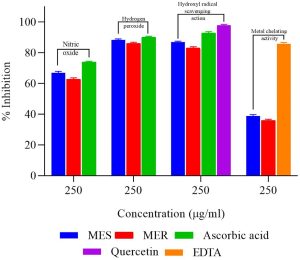
ABSTRACT
Background: In this present work, methanol extracts of the leaves and flowers of Salvia officinalis Linn. (MES) and Rosmarinus officinalis Linn. (MER) were examined for their potential anti-aging and antioxidant properties using in vitro methods. Materials and Methods: Several in vitro methods and techniques, such as estimation of reducing power, DPPH radical assay, ABTS decolorising assay, total antioxidant activity, superoxide radical (O2 • -), metal chelating activity, hydrogen peroxide and hydroxyl radical scavenging assay and assay of scavenging of nitric oxide were employed to appraise the scavenging of free radicals and antioxidant action of MES and MER. The anti-aging activity of the extracts was evaluated using the enzyme inhibition assays involving elastase inhibitory assay, collagenase inhibitory assay, and hyaluronidase inhibitory activity models. Using the elastase inhibitory assay, collagenase inhibitory assay, and hyaluronidase inhibitory assay models, the mechanistic antiaging potential of the extracts (MES and MER) had been appraised. Results: Because of their lower IC50 values, the extracts (MES and MER) showed significant antioxidant activity. It was discovered that they had poor metal chelating activity. By inhibiting elastase, collagenase, and hyaluronidase activity, both extracts showed significant anti-aging properties. Conclusion: The conclusions of this present research work thus imply that both the plant extracts possess the potential to act as antioxidant and may be used in herbal treatment for both normal and photoaging.
